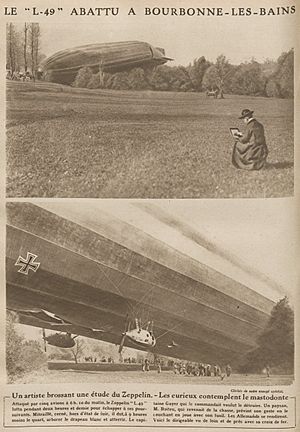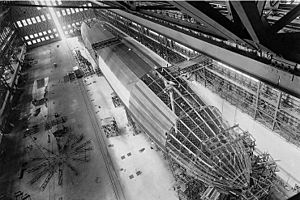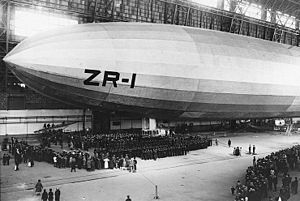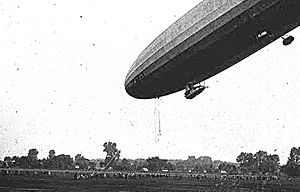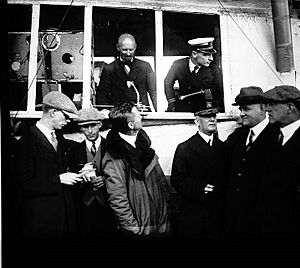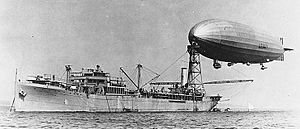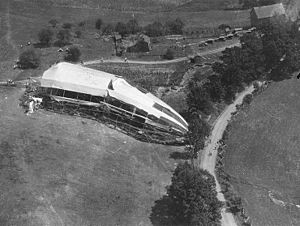USS Shenandoah (ZR-1) facts for kids
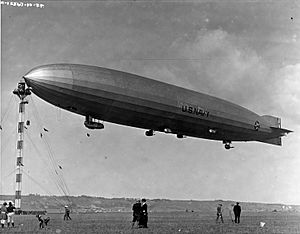
USS Shenandoah moored at NAS San Diego
|
|
| History | |
|---|---|
| Name | USS Shenandoah |
| Namesake | Shenandoah Valley |
| Ordered | 11 July 1919 |
| Builder |
|
| Laid down | 24 June 1922 |
| Launched | 20 August 1923 |
| Christened | 10 October 1923 |
| Commissioned | 10 October 1923 |
| Maiden voyage | 4 September 1923 |
| Stricken | 5 September 1925 |
| Honors and awards |
First transcontinental U.S. flight |
| Fate | Crashed during a thunderstorm near Caldwell, Ohio, 3 September 1925 |
| Notes |
|
| General characteristics | |
| Class and type | Shenandoah-class rigid airship |
| Tonnage | 77,500 lb (35,200 kg) |
| Length | 680 ft (207.26 m) |
| Beam | 78 ft 9 in (24.00 m) (maximum diameter) |
| Height | 93 ft 2 in (28.4 m) |
| Propulsion | Six (later five) 300 hp (220 kW) eight-cylinder Packard gasoline engines |
| Speed | 60 kn (69 mph; 110 km/h) |
| Range | 5,000 mi (4,300 nmi; 8,000 km) |
| Capacity |
|
| Complement | 25 |
| Armament |
|
| Official name | Shenandoah Crash Sites |
| Designated | 25 July 1989 |
| Reference no. | 89000942 |
| Coordinates | Site #1: 39°50′21″N 81°32′22″W / 39.83917°N 81.53944°W Site #2: 39°50′7″N 81°32′46″W / 39.83528°N 81.54611°W Site #3: 39°44′29″N 81°35′36″W / 39.74139°N 81.59333°W |
The USS Shenandoah was a huge airship, like a giant flying cigar, built for the United States Navy. It was the very first rigid airship used by the U.S. Navy. What made it special was that it was also the world's first rigid airship to be filled with helium gas instead of hydrogen. Helium is much safer because it doesn't catch fire.
Built between 1922 and 1923, the Shenandoah was designed to help the Navy learn about these amazing flying machines. It made history by being the first airship to fly all the way across North America. Sadly, on its 57th flight in September 1925, the Shenandoah was caught in a powerful storm over Ohio and crashed.
Contents
Building a Giant Airship
The Shenandoah was originally called FA-1, meaning "Fleet Airship Number One," but its name was changed to ZR-1. This massive airship was about 680 ft (207.26 m) long, which is longer than two football fields! It weighed about 36 tons. It could travel 5,000 mi (4,300 nmi; 8,000 km) and reach speeds of 70 mph (61 kn; 110 km/h).
The Shenandoah was put together at Naval Air Station Lakehurst in New Jersey. This base had the only hangar big enough for such a huge ship. Its parts were made at the Naval Aircraft Factory in Philadelphia.
Inspired by Zeppelins
The design for the Shenandoah was based on a German airship called the Zeppelin L-49. This Zeppelin was built in 1917 and was known for being able to fly very high. The American designers made some changes and improvements to this original design.
The airship's frame was built from a new, strong, and light metal alloy called duralumin. This metal is a mix of aluminum and copper. The outside of the airship was covered with a special cotton cloth. This cloth was painted with a substance called "dope" to make it smooth and strong.
Gas Cells and Helium Power
Inside the airship's frame were 20 large gas cells. These cells held the gas that made the airship float. They were made from a very thin material called "goldbeater's skins." This material came from the intestines of cattle and was excellent at holding gas. Each cell had valves to release gas if needed.
The Shenandoah was the first rigid airship to use helium gas instead of hydrogen. This was a huge step forward for safety. Hydrogen is very flammable, meaning it can easily catch fire and explode. Helium, on the other hand, is safe and does not burn. At the time, helium was very rare and expensive. The Shenandoah used most of the world's supply just to fill its 2,100,000 cubic feet (59,000 m3) volume.
The airship was powered by six (later five) Packard gasoline engines, each with 300 hp (220 kW). Because helium was so costly, the engineers found a clever way to save it. They installed special equipment to capture the water vapor from the engine exhaust. This water helped keep the airship's weight balanced as fuel was used, so they didn't have to release precious helium.
Early Flights and Missions
The Shenandoah made its first flight on September 4, 1923. It was officially named and put into service on October 10, 1923. Mrs. Edwin Denby, whose husband was the Secretary of the Navy, christened the airship. She named it after the Shenandoah Valley in Virginia, her home. The word "Shenandoah" was thought to mean "daughter of stars" in a Native American language.
The airship was designed to scout for the Navy, much like German airships did in World War I. Its early flights in 1923 tested how well it could fly in different weather, like rain and fog. On Navy Day, October 27, the Shenandoah flew over the Shenandoah Valley, Washington, D.C., and Baltimore. Crowds gathered to see the new airship lit up by searchlights.
Arctic Exploration Plans and Setbacks
Rear Admiral William A. Moffett, a strong supporter of airships, wanted the Shenandoah to explore the Arctic. He believed it could gather important weather data and help the Navy learn about flying in cold conditions. The airship's ability to fly for long periods and at slow speeds made it seem perfect for this mission.
However, these plans were put on hold. On January 16, 1924, a strong storm hit Lakehurst. The Shenandoah's tail fin covering ripped, and the airship was torn from its mooring mast. It was blown backward, damaging its helium cells. It took several hours for the airship to be safely landed. Because of the extensive repairs needed, the Arctic trip was canceled.
Repairs were finished in May 1924. That summer, the crew worked on the engines and radio equipment to get the airship ready for Navy duties. In August, it joined the Scouting Fleet for practice exercises. The Shenandoah successfully found the "enemy" ships but lost them in bad weather. This showed that airships needed better support bases and maintenance ships to work well with the fleet.
First Flight Across North America
In July 1924, a Navy ship called the Patoka was changed to become the Navy's first airship support ship. A tall mooring mast was built on its deck, about 125 ft (38 m) above the water. The Patoka also got extra rooms for the Shenandoah's crew and supplies like helium and fuel.
The Shenandoah practiced mooring to the Patoka to see if a ship could support airships at sea. The first successful mooring happened on August 8. Then, in October 1924, the Shenandoah made a historic flight. It flew from Lakehurst, New Jersey, all the way to California and then to Washington state. This was the first time a rigid airship had ever flown across North America!
The first half of 1925 was spent on maintenance and ground tests for the Shenandoah. It didn't fly again until June 26, when it started getting ready for summer operations with the fleet. In July and August, it again worked with the Scouting Fleet. It successfully completed its scouting missions and was even towed by the Patoka while moored to its mast.
The Shenandoah's Final Flight
On September 2, 1925, the Shenandoah left Lakehurst for a special flight to the Midwest. The plan was to fly over 40 cities and visit state fairs to promote airship technology. It was also going to test a new mooring mast in Dearborn, Michigan.
Early in the morning of September 3, during its 57th flight, the airship flew into a severe thunderstorm over Ohio. It was caught in a powerful updraft, which is a strong current of rising air. This updraft pushed the airship higher than it was designed to go, causing its gas bags to expand too much. The airship was torn apart by the strong winds and crashed in several pieces near Caldwell, Ohio.
Fourteen crew members, including Commander Zachary Lansdowne, lost their lives in the crash. Most of the crew in the control car died, as did some mechanics and two men who fell through holes in the hull. However, 29 people survived! They rode three different sections of the airship safely to the ground. The largest group of 18 men survived in the stern (back) section. Four others survived in the middle section. The remaining seven were in the bow (front) section, which Commander Charles E. Rosendahl managed to steer like a hot air balloon.
Crash Sites and Memorials
The Shenandoah crash sites are located in the hills of Noble County.
- Site No. 1 is where the airship first broke apart, near the Gamary farmhouse. There are markers showing where Commander Lansdowne's body was found.
- Site No. 2 is about one-half mile (0.80 km) southwest, where the stern of the airship landed. Concrete blocks mark its rough shape, and a sign is visible from the highway.
- Site No. 3 is about six miles (9.7 km) southwest, where the bow section of the Shenandoah was secured to trees. A small granite marker remembers the crash here.
After the crash, two main ideas came up about what caused it. One idea was that the gas cells expanded too much as the airship rose. This happened because 10 of the automatic release valves had been removed. Without these valves, the expanding gas damaged the airship's frame, leading to its breakup.
After the Disaster
Looting at the Crash Site
The crash site quickly attracted thousands of visitors. Within hours, people began taking pieces of the wreckage as souvenirs. Newspapers reported that the site was "looted" by locals. Important items like the ship's logbook and a device called a barograph (which records air pressure) were believed to have been taken. These items were crucial for understanding how the crash happened. Many of the valuable silk gas cells were also taken before military personnel arrived.
A local farmer, whose land held part of the wreckage, even started charging visitors to enter the crash site. He charged $1 for each car and 25 cents per person walking in.
Official Investigation and Changes
An official investigation looked into the cause of the crash. It was revealed that Commander Lansdowne had protested making the fatal flight. He had warned the Navy Department about the severe weather common in that part of Ohio in late summer. However, his superiors wanted to promote airship technology and show taxpayers that the expensive airship was worth it. So, publicity won over safety.
This event led to Army Colonel Billy Mitchell criticizing the leadership of both the Army and Navy. This criticism eventually led to his court-martial. An expert named Anton Heinen said that the crash was partly due to removing eight of the airship's 18 safety valves. These valves were taken out to save helium, which was very rare and important at the time. Without enough valves, the helium expanded too quickly as the airship rose, tearing the gas bags and then the hull.
After the Shenandoah disaster, airship designs were improved. Hulls were made stronger, control rooms were built into the main structure, and engines were made more powerful. More attention was also paid to getting accurate weather forecasts to prevent similar tragedies.
Memorials and Legacy
Several memorials are located near the crash site in Ohio. There is also a memorial at Moffett Field, California, and a small private museum in Ava, Ohio.
The local school district in the area where the Shenandoah crashed, Noble Local School District, named its schools after the airship. Their sports teams are even called "The Zeps," short for "Zeppelin." A truck stop about 15 mi (24 km) away in Old Washington, Ohio, was named Shenandoah Plaza after the airship, though it has since closed.
See also
 In Spanish: USS Shenandoah (ZR-1) para niños
In Spanish: USS Shenandoah (ZR-1) para niños


